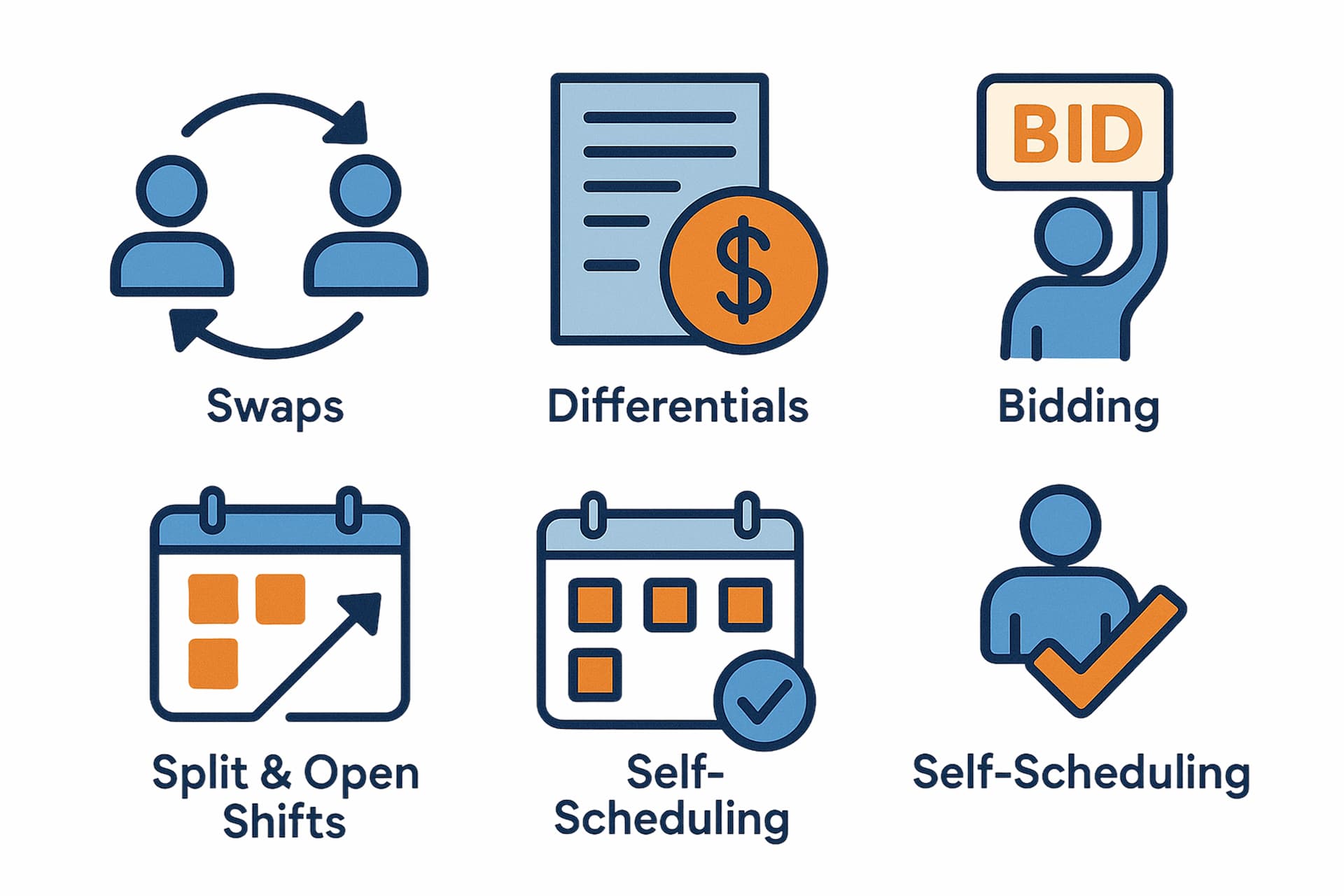Shift planning in healthcare is never simple - but for nurse managers, it’s often the hardest part of the job. Between skill levels, rest requirements, last-minute absences, and patient demand, building a fair, compliant schedule can take hours each week. The right nurse scheduling software makes that work smoother and smarter.
Whether you lead a hospital unit, outpatient clinic, or home-care agency, you need balanced coverage without burnout. Below you’ll find tested tools nurses and managers actually like using - and how to roll them out effectively.
Must-have features for nurse scheduling
Scheduling nurses isn’t like staffing other industries. You must balance clinical coverage, fatigue limits, and fairness while keeping patient safety first. Here’s what the best software includes:
Fairness & preferences. Nurses care deeply about their schedules - allowing visibility into preferences, swaps, and overtime builds trust and reduces stress.
Skill-based assignments. The right tool matches credentials and experience to patient needs, ensuring the right nurse is always on the right unit.
Fatigue and rest control. Long shifts and short turnarounds cause burnout. Smart systems enforce rest periods and limit overtime to keep nurses safe and alert.
Predictive staffing. Instead of reacting to gaps, predictive tools forecast census changes and recommend coverage early.
Mobile access & shift swaps. Nurses move between floors and facilities. A mobile app lets them view, swap, and confirm shifts instantly.
Real-time schedule updates. When assignments change, notifications go out immediately so no one misses an update.
Compliance & licensing. The platform tracks credentials and ensures shifts meet union, labor, and certification rules.
Built-in communication. Messaging and announcements happen inside the same system, reducing errors from separate chat apps.
Analytics & reporting. Track overtime, utilization, and scheduling trends to improve staffing decisions and prevent burnout.
Efficiency & retention. Less manual work means happier staff, better work-life balance, and lower turnover.
How nurse scheduling software works
Good nurse scheduling tools combine automation with visibility. Managers set up units, skills, and shift templates; staff update their availability and request time off. The system then builds or suggests a balanced schedule that meets coverage and compliance rules.
Nurses can view schedules on any device, receive real-time alerts for new shifts, and request swaps or PTO. Managers see coverage gaps at a glance, adjust staffing, and instantly publish changes. Everything connects to attendance tracking - reducing duplicate data entry.
In short, nurse scheduling software replaces chaotic spreadsheets with clear, fair, and automated workflows that protect both patients and staff.
Best nurse scheduling software
Below are top-rated tools hospitals, clinics, and care agencies use to manage nurse shifts. We summarize what each does best, pricing, and key user insights.
Shifts by Everhour
Best for unified scheduling + time tracking with clean mobile experience
- Free plan available
- From $4/user/month (billed annually)
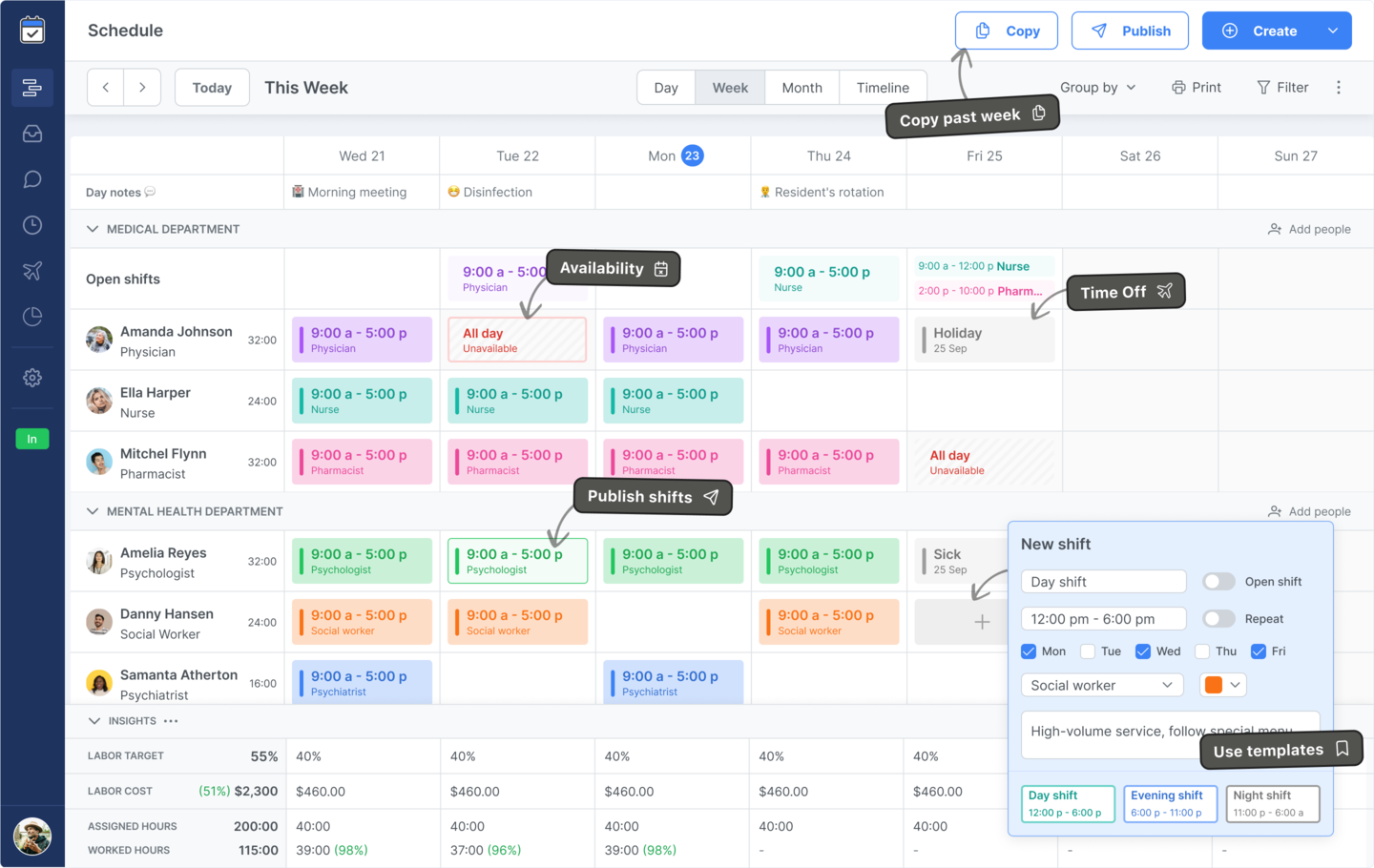
Shifts by Everhour brings schedules, time clocks, PTO, and team messages into one place-ideal for clinics, private practices, home-health, and departments that need clarity over complexity. Explore employee shift scheduling, scheduling + time clock, and engagement tools.
Key Features
- Combined scheduling + GPS time clock
- Mobile self-service: swaps, bids, PTO, availability
- Open shifts, templates and instant publish
- Team messaging & announcements in one app
- Clear visibility into overtime and labor hours
- Simple rollouts for small to midsize care teams
Pros / Cons
- One app for schedules, time, and communication
- Fast onboarding, intuitive for non-technical staff
- Great for multi-site outpatient and home-health
- Fewer deep enterprise integrations
- Advanced analytics still evolving
Connecteam
Best for all-in-one operations with HIPAA-friendly workflows
- Free plan for small teams (feature-limited)
- Tiered pricing by feature set
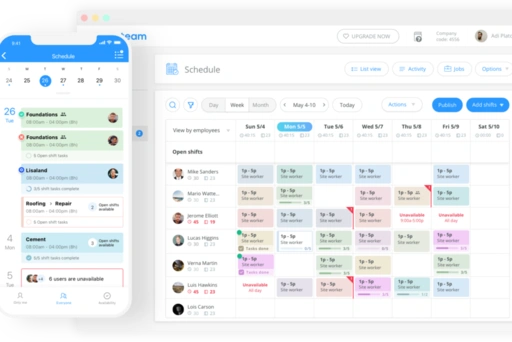
Often praised for a HIPAA-compliant, user-friendly interface. Combines scheduling with tasking, forms, and training modules-useful for multi-site clinics and ancillary departments.
Key Features
- Drag-and-drop scheduling & shift templates
- Mobile app with self-service requests
- Forms, checklists, training, and chats
- Role-based permissions and auditing
- Kiosk and GPS time clocks
- Basic reporting & acknowledgments
Pros / Cons
- Broad “all-in-one” feature set beyond scheduling
- Simple mobile UX helps adoption
- Depth of scheduling analytics varies by plan
- Can feel heavy if you only need scheduling
Deputy
Best for labor cost control with robust scheduling + timekeeping
- Free trial available
- From ~$4.50–$6.50/user/month (annual)
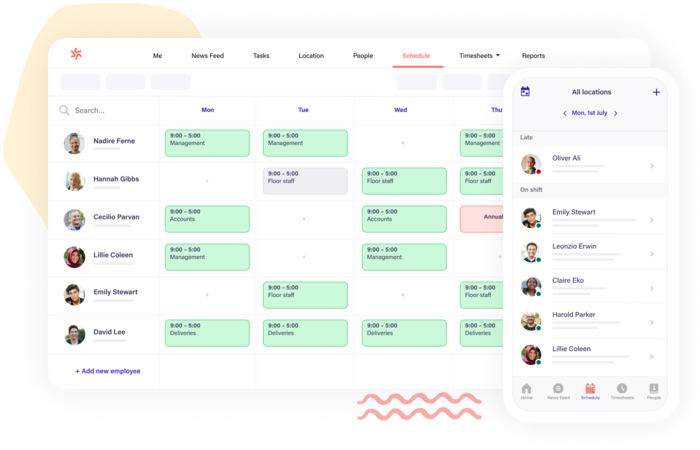
Deputy ties schedules tightly to attendance and overtime rules, helping prevent overages while keeping teams informed. Popular in high-volume environments (urgent care, outpatient, ancillary services). Related reads: hospital scheduling software.
Key Features
- Intuitive schedule builder & mobile clock-in/out
- Real-time compliance (overtime, breaks)
- Multiple location & role support
- Shift swap, open shifts, notifications
- Timesheets & payroll integrations
- Basic demand forecasting
Pros / Cons
- Good balance of ease-of-use and control
- Strong timekeeping + scheduling linkage
- Some advanced reports behind higher tiers
- Occasional mobile performance complaints
Sling
Best for budget-friendly scheduling with cost visibility
- Free plan (limited)
- From ~$1.70/user/month (annual) for premium tiers
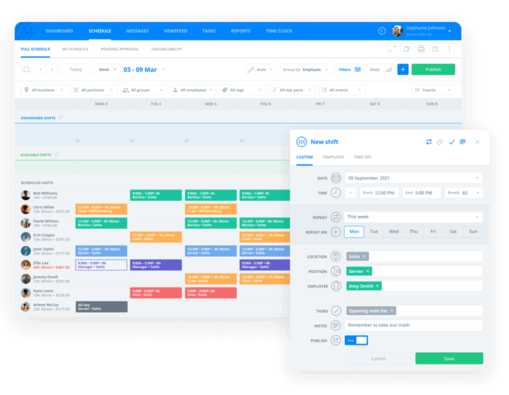
Sling offers simple scheduling plus labor-cost views-handy for outpatient clinics, imaging centers, and ancillary departments managing tight margins. See also our free scheduling software comparison.
Key Features
- Shift scheduling with cost estimates
- Attendance & clock-in/out options
- Team messaging & alerts
- Open shifts & swap requests
- PTO & availability tracking
- Basic reporting
Pros / Cons
- Very affordable for small departments
- Simple, quick to roll out
- Mobile interface less polished for some users
- Fewer advanced compliance features
QGenda
Best for enterprise-grade provider scheduling & workforce optimization
- Demo-based pricing
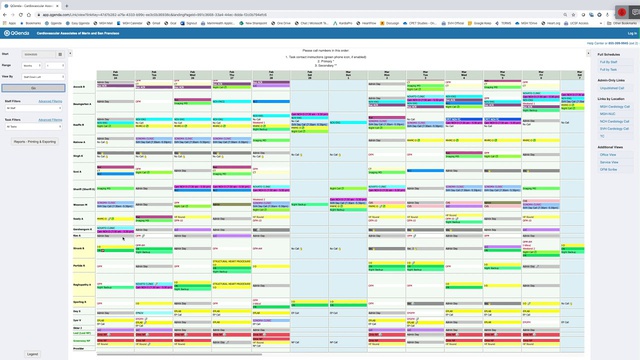
A widely adopted hospital platform emphasizing provider scheduling, on-call, and optimization for patient access. Users highlight customization and helpful support; setup can be complex and time-consuming for large orgs.
Key Features
- Physician & APP scheduling with complex rules
- On-call rosters, rotations, and request workflows
- Analytics on utilization and access
- Role-based portals & mobile access
- Integrations with hospital systems (varies)
- Enterprise controls & auditing
Pros / Cons
- Powerful for complex provider groups
- Flexible configuration options
- Lengthy setup, steeper learning curve
- Mobile UX feedback varies by team
OnShift
Best for long-term care & senior living (scheduling + labor control)
- Demo-based pricing
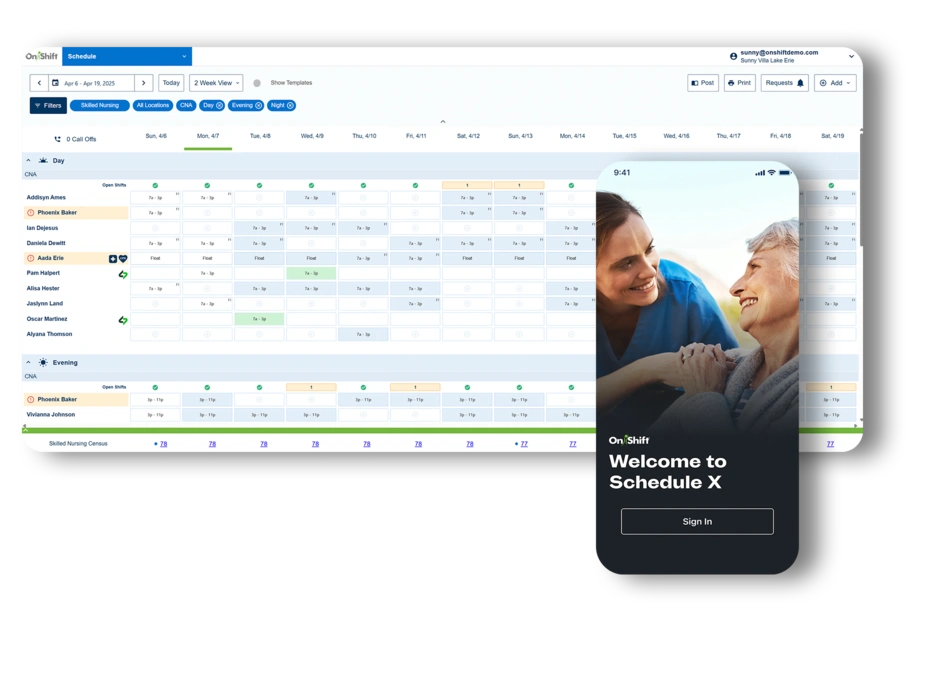
Suited to LTC and senior care. Users like ease of navigation and time-saving automation; some mention notification quirks and data-sync limitations in specific setups. See also our caregiver scheduling resources.
Key Features
- Scheduling with overtime & call-out controls
- Mobile access & messaging
- Timesheets & attendance
- Reports for staffing & cost
- Open shifts and swap workflows
- Multi-facility management
Pros / Cons
- Designed for LTC staffing realities
- Clear reports and hour tracking
- Notifications can be inconsistent for some users
- Setup/customization complexity at scale
MakeShift
Best for ease-of-use with strong shift trading and future planning
- Free trial available
- From ~$5.75/employee/month
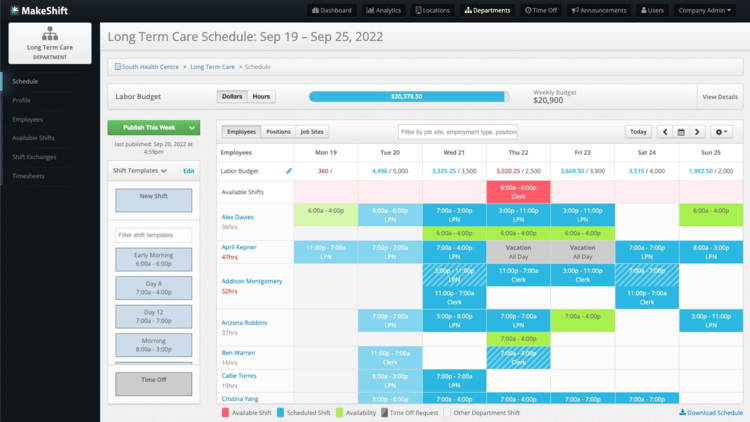
Users praise quick scheduling and time savings; wish lists include more customizable reports and richer communication tools. Good for clinics that value simple, clean UX.
Key Features
- Fast schedule building & future planning
- Shift trading & availability
- Mobile app for staff self-service
- Basic reporting & notifications
- Multi-location support
- PTO & approvals
Pros / Cons
- Very easy to learn for staff
- Great for shift trading
- Limited custom reporting for some needs
- Smaller ecosystem vs. big vendors
OnPage
Best for on-call alerting & incident response in clinical settings
- Free trial available
- From $13.99/employee/month
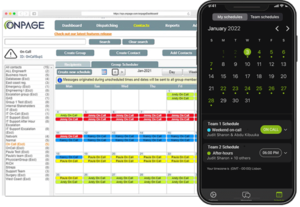
Complements scheduling with reliable critical alerting and on-call management. Users like dependable notifications; some report sound/transcription quirks and alert fatigue if misconfigured.
Key Features
- On-call scheduling & escalations
- Secure messaging & alerting
- Mobile apps with audit trails
- Integrations for incident workflows
- Message delivery confirmations
- Reporting on response SLAs
Pros / Cons
- Very reliable critical notifications
- Strong for on-call rotations
- Sound/transcription limitations noted
- Needs careful tuning to avoid alert fatigue
EasyShifts
Best for small clinics wanting quick, simple scheduling
- Free trial available
- From $4.99/employee/month
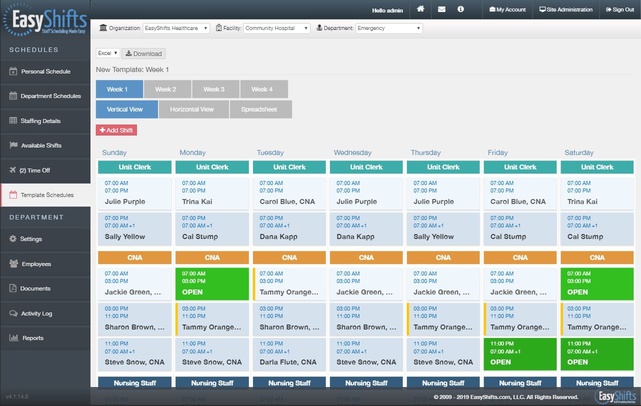
Praised for simplicity and helpful support; feature limits and occasional notification issues are noted by some users. A lean choice for small teams and single-site clinics.
Key Features
- Quick schedule edits & mobile access
- Open shifts & availability
- PTO requests & approvals
- Basic reporting & alerts
- Real-time shift updates
- Light learning curve
Pros / Cons
- Very fast to get started
- Support often rated highly
- Limited PTO and customization for some needs
- Occasional glitches entering availability
Featured Nurse Scheduling Tools
How to choose the right nurse scheduling software
Choosing the right nurse scheduling solution depends on your unit’s size and staffing patterns. Large hospitals need multi-department logic; clinics and home-care teams benefit most from mobile tools and quick templates.
Look for automation that fits your workflow - shift rotations, rest rules, and approval hierarchies. Test whether nurses can easily swap or claim shifts from the app. Real adoption depends on how intuitive it feels for staff at every level.
Benefits for nurses & administrators
Better scheduling helps both sides of healthcare. Nurses gain predictability, rest, and fairness; administrators get full visibility, accurate labor data, and fewer gaps.
Automated tools prevent understaffing and fatigue while improving communication between departments. Fewer last-minute changes mean calmer shifts and safer care.
Balanced schedules improve satisfaction and retention. When nurses feel respected and heard, they stay longer - and patients feel the difference.
Implementation tips
Roll out new software gradually - start with one department, gather feedback, and share quick wins to build momentum.
Begin with a pilot shift group. Test real workflows, collect input, and adjust before scaling across the facility.
Keep training short and practical. Interactive demos help nurses adopt features faster than manuals ever could.
Focus on self-service. When nurses can manage availability and swaps themselves, engagement grows naturally.
The bottom line
Nurse scheduling is about more than coverage - it’s about fairness, rest, and safe care. Pick software that balances automation with empathy and helps every shift run smoothly.

